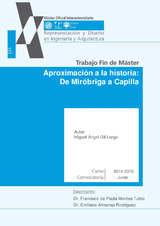Aproximación a la historia: de Miróbriga a Capilla
Autor
Gil Largo, Miguel Ángel
Tutor
Montes Tubío, Francisco de PaulaAlmansa Rodríguez, Emiliano
Editor
Universidad de CórdobaFecha
2016Materia
CapillaMiróbriga Turdulorum
Pintura rupestre
Estelas
Castillo
Cave painting
Trails
Castle
METS:
Mostrar el registro METSPREMIS:
Mostrar el registro PREMISMetadatos
Mostrar el registro completo del ítemResumen
Capilla ha sido foco de asentamientos humanos desde la más remota
antigüedad, como lo testimonian las abundantes pinturas rupestres de la
zona. Con los celtas fue Miróbriga Turdulorum, bajo dominación romana
continuó siendo un centro poblado de notable importancia, como lo
atestigua el que Plinio, lo denominara insigne municipio.
Durante la ocupación musulmana fue también un enclave estratégico
destacado en el eje de las comunicaciones entre Mérida, Sevilla,
Córdoba, Almadén y Toledo. Por tal razón, sobre sus escarpaduras
existieron en todos los tiempos, sólidas fortificaciones, que evidencian la
importancia del lugar como nudo de comunicaciones.
Capilla fue conquistada en el año 1226, aunque posteriormente volvería
a caer en manos musulmanas hasta que definitivamente fue tomada por
los templarios. En el año 1309, al extinguirse la Orden del Temple, pasó a
formar parte de las propiedades del Maestre de Alcántara, don Gonzalo
Pérez y el castillo musulmán de Capilla, fue reedificado por los cristianos.
A finales del siglo XIV pasó a la Casa de Béjar, al ser comprada por el
camarero mayor del rey, don Diego López de Stúñiga, en el año 1382 por
la cantidad de 280.000 maravedís. En los primeros años del siglo XVI pasó
a formar parte del patrimonio de uno de sus descendientes, en el
testamento de don Álvaro de Zúñiga con la otorgación de Capilla y
Burguillos. En 1777, al fallecer sin sucesor el XII duque de Béjar, heredó este
estado la XII duquesa de Benavente, esposa del IX duque de Osuna,
pasando a formar parte de los inmensos dominios de la poderosa Casa
de Osuna.
En el aspecto jurisdiccional, desde la Reconquista fue capital del Estado
de su nombre, en el cual se incluían las poblaciones de Garlitos, Baterno,
Peñalsordo y Zarza Capilla. Hoy día es un pequeño pueblo que apenas
cuenta con 300 habitantes. Capilla has been the focus of human settlements since ancient times, as
witnessed in the numerous rock paintings in the area. With the Celts it was
Miróbriga Turdulorum, and, under Roman rule, it continued being a
town of considerable importance, evidenced by the fact that Pliny
denominated it as distinguished town.
During the Muslim occupation it was also an outstanding strategic
enclave in the shaft leading communications between Mérida, Sevilla,
Córdoba, Almadén and Toledo. For this reason, on their
escarpments, strong fortifications existed in all times, showing the
importance of the place as communications hub.
Capilla was conquered in 1226, but later on it fell back into Muslim hands
until finally it was occupied by the Templars. In 1309, after the extinction of
the Knights Templar, it became part of the properties of the Master of
Alcántara, Don Gonzalo Pérez. The Muslim castle of Capilla was rebuilt by
the Christians.
At the end of fourteenth century, it was passed to the House of Béjar, after
being purchased by the amount of 280,000 maravedis in 1382, by the
major waiter of the King, Don Diego López de Stúñiga,. In the early
sixteenth century, it became part of the heritage of one of his
descendants when both Capilla and Burguillos were granted in the will of
Don Alvaro de Zuniga. In 1777, when the XII Duke of Béjar died without a
successor, the XII Duchess of Benavente, wife of the ninth Duke of Osuna,
inherited this state, and it became part of the vast domain of the powerful
house of Osuna.
From the jurisdictional view, since the Reconquista, it was the capital
of the state with the same name, in which were also included the
population of Garlitos, Baterno, Peñalsordo, and Zarza Capilla. Today it is
a small village of hardly 300 inhabitants.
Descripción
Premio extraordinario de Trabajo Fin de Máster curso 2014-2015. Representación y Diseño en Ingeniería y Arquitectura

